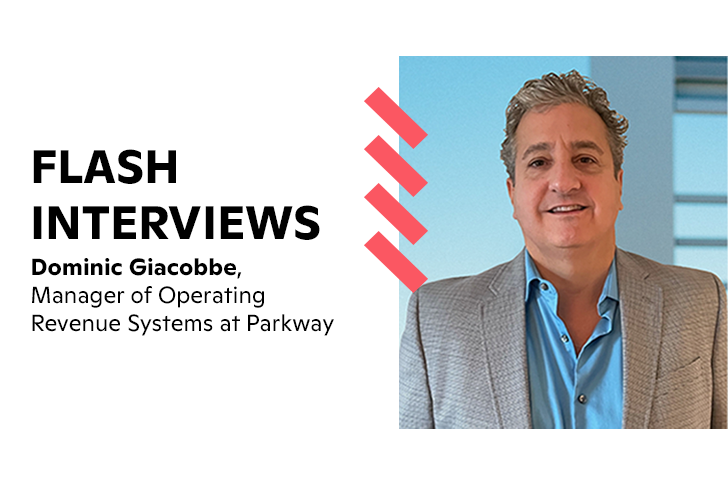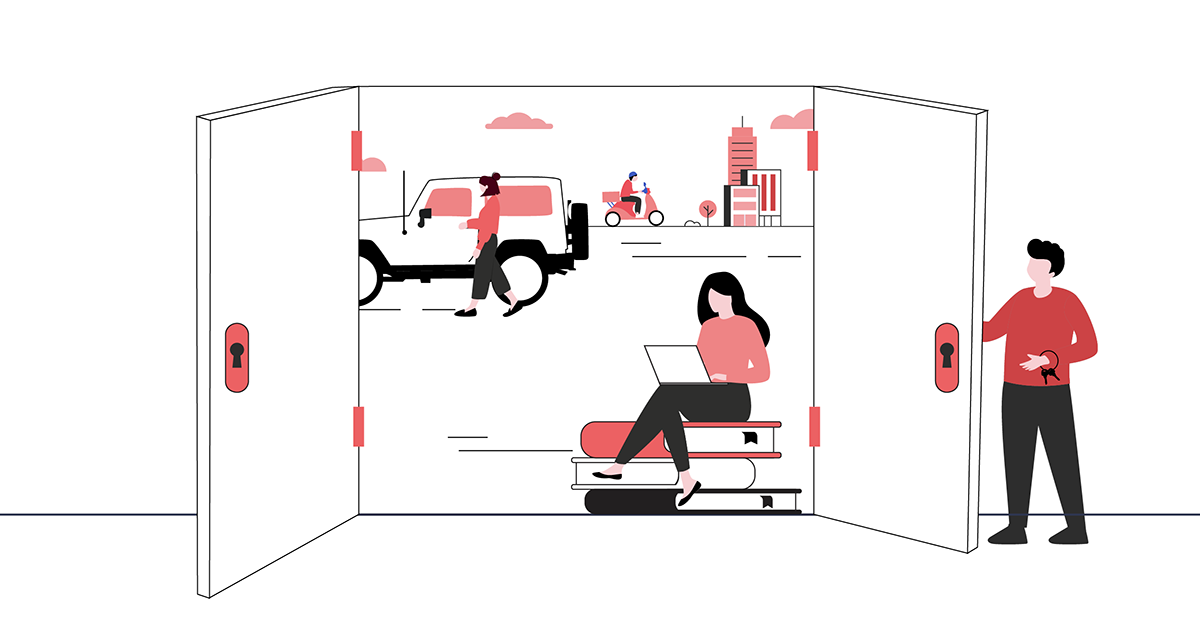“We’re in discussions with different city departments, and I talk to people all around the country about how we can connect everything together,” says Adam Jones of the Downtown Tempe Authority in Tempe, Arizona. Jones is sharing his belief that linking municipal operations through technology is one of the keys to a healthy city and parking structure.
Jones is the Vice President of the enhanced services district, where his role stands at the intersection of parking operations and IoT strategy, or the “Internet of Things.” He “grew up” in the parking industry, beginning as a cashier at age 14, then eventually managing entire cities. As Vice President of Operations and Parking, he oversees public safety programs, municipal landscaping and cleaning, and largest of all—parking.
Due to spending so much time in the industry, Jones has a deep understanding of how parking is evolving with changes such as flexible work weeks. He knows that commuter habits are shifting, and cities are becoming more interconnected with consumer services and technologies. In a phrase: cities are becoming smarter.
Jones and his team manage roughly 19,000 parking spaces, including private parking operations. We talked with him about changes in parking patterns in Downtown Tempe and how these changes might affect urban planning in the near future. One thing is certain: parking is going to be getting much smarter.
FlashParking: To begin, how has the flexible work week changed on- and off-street parking in downtown Tempe so far?
Adam Jones: I don’t think we’ve seen the true change yet. From our perspective, and I think this is pretty similar across the country, the vast majority of our office workers have not come back yet. So, we’re still operating at 85% vacancy or 15% utilization, if you want to look at it that way.
As we get later into 2021, I anticipate that we’re going to see companies finding it easier to retain employees by offering more flex work schedules. What I keep hearing from the commercial real estate industry is that we’re looking at a three-two situation—three days a week in the office and two days out. That’s going to change how we have traditionally charged for parking in the past. As more and more leases get renewed, and new leases get drawn up, that’s going to be a point of negotiation going forward. [And it’s] never really been part of traditional negotiations in the past.
FP: Sounds like a challenge and an opportunity. Are there other immediate challenges that you’re facing from a lower occupancy rate?
AJ: We’re really just trying to keep things moving forward—operating, taking advantage of the time to do deferred maintenance activities and things of that nature. We’re trying to capitalize on the vacancy that we do have so that when the economy comes back and the pandemic is over, we’re fully ready and capable to handle all the folks that come back. More importantly, we’ll be able to adjust on the fly to changes as they happen. What may be happening today can change in six months or a year from now. Things change very rapidly now.
FP: Can you expand on how you’re taking advantage and capitalizing on the current situation?
AJ: We’ve always been big at looking at shared parking arrangements. [Traditionally], a property might need five spaces per thousand, and [a separate] property might need five spaces per thousand. When you start looking at the two businesses and how they’re aligned, they can actually share one parking facility or one group of spaces. Two years ago, the movement we were seeing was to pack as many employees as you can into an office building and move forward. Fast forward to today, it’s going to be the exact opposite. So, how do we adjust to that?
Some may say [flexible work] is going to generate more of a demand for parking, and some say less or latent demand. I don’t know how it’s going to shake out, but I would lean on less demand than more demand.
“My goal with smart parking initiatives is to give the customer as many choices and the greatest possible ease of ingress and egress into and out of a parking garage.”
FP: You’ve been in discussions about smart cities and smart parking. What does smart parking, or a smart parking city, mean to you, and how can it apply to changing work structures or less parking demand?
AJ: I think of it in two facets. First of all, when I think of smart parking or smart cities, I think of making parking as easy as possible. If you have to think about parking, and it’s typically a negative topic of discussion, then you probably have a problem. My goal with smart parking initiatives is to give the customer as many choices and the greatest possible ease of ingress and egress into and out of a parking garage.
Outside of that, we strive for ease of access and a myriad of choices that they’re going to have. For example, we’ve typically heard of daily parking and monthly parking. That may not work for everybody going forward. We may have to get creative and do weekly passes, and we may have to do passes that allow for so many accesses per month. So, we just have to listen to the people—to see what they’re doing and how they’re working, and adjust how we typically have charged in the past to the new way of doing business.
Lead the Charge
A FREE eBook breaks down the numbers behind the EV revolution and highlights parking’s critical role in the big picture. Hint: there’s a big opportunity you don’t want to miss.
FP: Have you thought about introducing new amenities, partnerships, or logistics to maximize the use of space in parking garages and adjust to the future of work?
AJ: Yes. The concept that emerged over the past couple of years is the mobility hub. It’s not just a parking garage—you might be able to rent a car, drop off a car, or grab a bicycle or scooter once you’ve parked. We’re looking at whatever we can do to add to the experience. Simply, everything we should be doing is making it easier for the customer—more choices and greater flexibility in pricing.
Also, any kind of relationship or joint venture that we go into should be something that will make things easier. For example, more choices to pay. [Parking] used to be a cash business. Then, it was cash with a credit card business, then mobile payments. Now, we’re offering Google and Apple Pay and reservation systems. [Partnerships] are also another way to tap into a new customer group.
“One technology that’s come a long way and is starting to expand is communicating parking garage occupancy and egress rates with traffic engineering or traffic lights to adjust automatically based on traffic flow. This will grow in importance and be very beneficial.”
FP: This conjures up the idea of IoT, or the “Internet of Things”—how you’re connecting different technologies to make it easier for the customer. Are there any conversations or thoughts you’ve had regarding IoT applications in parking?
AJ: We’re in discussions with different city departments, and I talk to people all around the country about how we can connect everything together. One of the biggest challenges we’ve had here, pre-pandemic, was traffic congestion at rush hour in the evenings and also during special events. One technology that’s come a long way and is starting to expand is communicating parking garage occupancy and egress rates with traffic engineering or traffic lights to adjust automatically based on traffic flow. This will grow in importance and be very beneficial.
FP: Based on your experience with the concept of IoT parking systems, what should parking leaders be thinking about to capitalize on current situations and prepare for the future of parking?
AJ: We’ve been looking at getting back to ease of transactions—whether it’s touchless or mobile. We’re also accepting reservations. Then, we’re looking at partnership opportunities, [such as] if you purchase parking at a certain location, it can be an opportunity to market another establishment. We’re also looking at loyalty programs. These are examples of what can be a main part of our strategy moving forward.
FP: This year, the first of 15 interactive kiosks were installed in the Downtown Tempe area. What benefits does something like this give to a city along with integrations with parking?
AJ: With those kiosks, named IKEs, you can do many things. Instead of having to look at a [separate] map, you can: look up any business that’s downtown, navigate, look at a menu and place an order, check in with social media, and get your picture taken. You can even look at local job boards and apply for a job right there.
It also connects to our parking opportunities. You can look up available parking and purchase it online. Whether it’s someone coming downtown to park or if it’s just someone enjoying downtown or taking public transportation, we want to make it at their fingertips and accessible.
FP: It seems that parking businesses might have a new understanding of consumer activities or habits with the kiosks as well.
AJ: Exactly. Right now, we do physical counts at every major intersection with pedestrians and vehicles. That helps businesses by knowing what the pedestrian load is on a corner at any given time. From a parking standpoint, if we can tie that usage and availability to a wayfinding app, that’s going to help people get to available parking quicker.
FP: There’s a new community dubbed “Culdesac Tempe,” an upcoming Phoenix suburb that will ban cars on site. Is there an opportunity that exists there for parking companies?
AJ: Culdesac Tempe is not in the immediate downtown area, but it is very close to a light rail stop. There will be some parking on site that will be for visitors or retail components. There might be opportunities around to have areas where you can have short-term leasing or renting where parking companies might offer this type of service. The project is catering to a particular group of people that crave a lifestyle where everything that they need is either in their community or just a light rail train ride away.
“The concept that emerged over the past couple of years is the mobility hub. It’s not just a parking garage—you might be able to rent a car, drop off a car, or grab a bicycle or scooter once you’ve parked. We’re looking at whatever we can do to add to the experience.”
FP: It brings up the idea of micro-mobility—that companies have to go beyond parking to match changing behaviors or lifestyles.
AJ: Sure. We’ve looked at and will continue to look at the use of micro-mobility. So, if you have a parking garage that’s underutilized on the periphery of downtown, why not have an eight-passenger golf cart that’s willing to drive a particular route and deliver those people that might choose to park outside of downtown a little ways? It can help get them to where they’re going and avoid the congestion and the higher price parking.
FP: As a manager of municipal parking, what are your main priorities when searching for parking solutions?
AJ: Our main priority is to deliver the best available service and options to our end user. We’re constantly looking for what is best-in-class and what will offer our visitors the most available options and the easiest way to conduct a transaction. That’s what’s most important to us.
Learn more about the Downtown Tempe Authority.
Join the Parking Revolution, Subscribe
to Our Newsletter
We’re disrupting the parking industry because we believe our customers, consumers, and cities deserve better.

How Parkway Is Preparing for the Flexible Work Week

